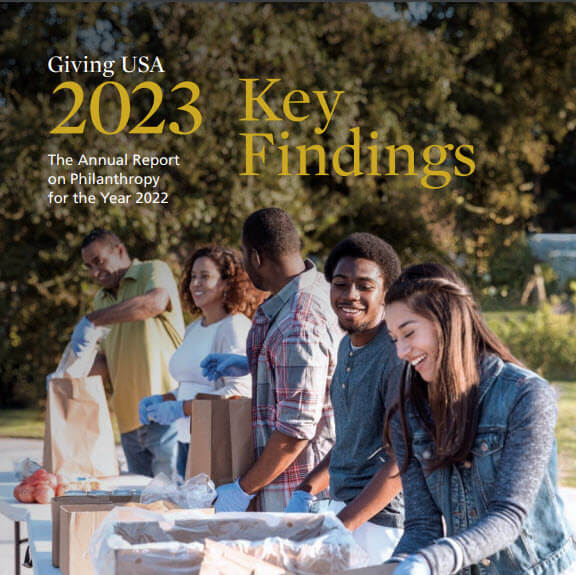With giving declining in 2022 for the fourth time in forty years, many are worried about the state of fundraising in 2023 and beyond. The Giving USA 2023: The Annual Report on Philanthropy for the Year 2022 is the most comprehensive report on philanthropy in America and the data within sheds light on the state of fundraising and ways nonprofits can overcome shortfalls in funding. Read on for our breakdown of the most important findings from the Giving USA 2023 Annual Report and our proposed solutions to the decline in household giving.

What the Giving USA 2023 Annual Report says about giving in 2022
It’s not surprising that giving by individuals declined 6.4% (a decline of 13.4% when adjusted for inflation) in 2022. With high levels of inflation, high interest rates, and a volatile stock market, many families backed off of charitable giving to ensure they could afford the essentials. With individuals giving the most of any group polled, this was particularly worrying because individuals make up the majority of fundraising dollars given in a year (64% of total giving in 2022). Individual giving totaled roughly $319.04 billion dollars out of the $499.33 billion given in 2022.
Giving by foundations managed to grow by 2.5 percent in 2022 to an estimated 105.21 billion dollars, making it the second largest group of contributions at 21% of total donations in 2022. Despite giving more in 2022 than 2021, the impact by foundations actually declined by 5% because of inflation.
Giving by bequest made up the third largest group of contributions, growing 2.3% in 2022 for an approximate total of $45.60 billion dollars. Again, however, when adjusted for inflation this translates to a loss of impact of 5.3%. Despite organizations recieving more bequests, they provided less in terms of goods and services for those nonprofits served.
Giving by corporations made up 6% of all donations, increasing 3.4% to $29.48 billion dollars in 2022. But once again, adjustments based on inflation shows a decline of 4.2%. Whether looking at cash or in-kind contributions made to nonprofits, it was noted that these donations had less impact because of inflation in 2022.
Giving by cause
Despite overall giving declining, not all nonprofit organizations were impacted the same and some even noted increases in giving when compared to 2021.
Religious organizations, for instance, reported a 5.2% increase in donations between 2021 and 2022. While inflation would determine that the religion subsector actually saw a 2.6% decline in donations, the outlook is less bleak for religious organizations because support for them is returning despite the economic uncertainty.
Human service organizations were less fortunate, seeing a 0.6% decrease in 2022 before adjusting for inflation and an 8% decline in giving after the adjustment. when it came to fundraising in 2022. This decline may not be entirely due to inflation though. Human services saw a huge rise in need during the pandemic but now that it’s over, the need in this subsector is naturally declining.
Giving to education also faltered in 2022, seeing a 3.6% decrease,10.7% decline when adjusted.
One area of growth was giving to foundations. Giving grew by 10.1% to about $56.84 billion which is still a growth of 1.9% when adjusted for inflation!
Giving to health organizations grew 5.1% between 2021 and 2022 before adjusting for inflation. When looking at how inflation impacted the subsector, there was a 2.6% decline in gifts’ impact.
Giving to public-society benefit organizations saw an 8.4% decrease in giving between 2021 and 2022. These organizations were especially hurt this year. When adjusted for inflation the decline widens to 15.2%, a major loss for this subsector.
International affairs nonprofits reported a 10.9% increase in donations betwen 2021 and 2022. This growth was likely spurred on by the conflict in Ukraine and devastating natural disasters that impacted Turkey and Syria. After adjusting for inflation, international affairs organizations reported a 2.7% growth in giving.
Giving to arts, culture, and humanities increased 2.9% between 2021 and 2022. However, adjusted for inflation, the subsector saw a decline of 4.7% to the impact of donations made.
Giving to environmental and animal organizations decreased 1.6% before adjusting for inflation. After the adjustment, the subsector declined by 8.9%.
Finally, giving to individuals grew slightly, 0.6% before inflation. When adjusted for inflation, donations to individuals declined by 6.8%. Note that the majority of donations to individuals are in-kind gifts of medication to patients in need made through patient assistance programs of pharmaceutical companies’ operating foundations.
What this means for giving beyond 2023
Focus on stewarding donors
Despite giving by individuals declining in 2022, individuals still made up the majority of all giving. To make up for the shortfall in individual giving, focus on donor stewardship to keep more of the donors you have because finding new donors may be more difficult in 2023 and beyond. As long as economic volatility is still a factor, many families will have a hard time continuing to make charitable contributions.
One strategy to help with this is to convert one-time donors to recurring donors. Not only do recurring donors tend to give more during their lifetime (and the year) than one-time donors, they also have higher retention rates meaning they’re more likely to stick around and continue contributing to your organization. Incorporate a recurring upgrade prompt on your online donation form to convince donors to make a recurring gift instead of a one-time contribution.
Acquire new donors
If you don’t have enough current donors in your database to sustain your organization, you can obtain new donors using peer-to-peer fundraising. On average, a peer-to-peer fundraiser introduces 300 new donors to a nonprofit organization if using the Qgiv platform. This means that you have 300 new opportunities to keep contributors to your peer-to-peer fundraiser. Wow them with your thank yous, and welcome them into the fold with an email welcome series. Don’t neglect your peer-to-peer participants. Be sure to thank them and share the impact their donations have on your organization.
Diversify your funding sources
Another strategy to implement if you’re seeing a decline in donations, as most nonprofits are, is to diversify your funding sources. While all giving declined in 2022, there were glimmers of hope in the form of foundations, bequests, and corporations, which gave more in contributions before adjusting for inflation. Despite the impact not going as far while inflation is still high, these contributors are in a better position to support your organization as they’re positioned to grow their giving in 2023.
In terms of fundraising priorities, your main focus should still be on the donors in your database. You want them to continue giving as they make up the majority of contributions to your nonprofit organization. Then, focus on attracting donations in the form of grants from foundations, bequests, and corporate donations.
Grants
In 2023, apply for grants from foundations that fund the kind of work that you do. This can mean applying for funding from local foundations or casting a wider net and looking for foundational support from organizations that give according to state, region, nationally, or internationally.
Planned giving
Your next area of focus when diversifying the gifts you receive is planned giving in the form of bequests. Work with local financial planning experts to inform your donors about planned giving and form partnerships to benefit your nonprofit organization when financial planning customers ask for nonprofits to support with their gifts. Bequests come in many forms, so determine what kinds of donations your nonprofit can receive and which it would have to turn away. In-kind gifts of vehicles, for instance, can cause a significant amount of stress when it comes to storing and selling them, whereas gifts of stock could significantly benefit your nonprofit.
One important thing to remember is that you don’t get bequests instantly. These are planned gifts because the donations are made after a donor passes away. That said, these gifts can be extremely valuable to your organization and can make it easier to cover operating expenses when they do come in.
Corporate giving
Lastly, grow your corporate giving in 2023 by applying for more corporate grants, asking for sponsorships, and partnering with local businesses in a meaningful and mutually beneficial way. Corporate giving comes in a variety of forms, so be open-minded about how you approach corporate giving.
Corporate grants
Some corporations have foundations that offer grants to nonprofits out of their corporate philanthropy account. Like a foundational grant, you’ll likely need to fill out an application to win a grant. Be sure to spell out exactly how much you’re requesting, what you need it for, and any other pertinent details about your organization that the corporation requests.
Sponsorships
For sponsorships, be sure to apply early for any sponsorship needs you may have. These funds can run out quickly because there is so much competition for corporate sponsorship funds, especially if you’re asking for a large amount of money. When you’re applying for a sponsorship be sure to tell the prospective sponsor what they’ll get for sponsoring and how their sponsorship will help your nonprofit.
Corporate partnerships
Lastly, you can partner with local businesses in a variety of ways to raise crucial funds for your nonprofit. For instance, you can set up a charity dinner with a local restaurant where a part of the proceeds from the night are donated to your organization. Other ways you can receive funds from local businesses are asking them to tell their employees about your organization and creating an employee giving campaign or event, setting up a corporate matching gifts campaign, or asking employees to volunteer for a volunteer grant.
In-kind goods and services
Remember, not every contribution needs to be a monetary donation. Instead, there are instances when asking for an in-kind gift of goods or services could benefit your nonprofit organization far more than money could. This is especially true if companies are willing to donate their time and energy to help with crucial repairs or upgrades at your organization or provide much-needed supplies to directly help those in need.
Conclusion
There you have it! These are the key statistics you’ll need from the Giving USA 2023: The Annual Report on Philanthropy for the Year 2022 to make data-backed decisions on the future of fundraising at your nonprofit organization.
Want more statistics you can use to make data-backed decisions at your nonprofit organization? Check out our blog post for more.







